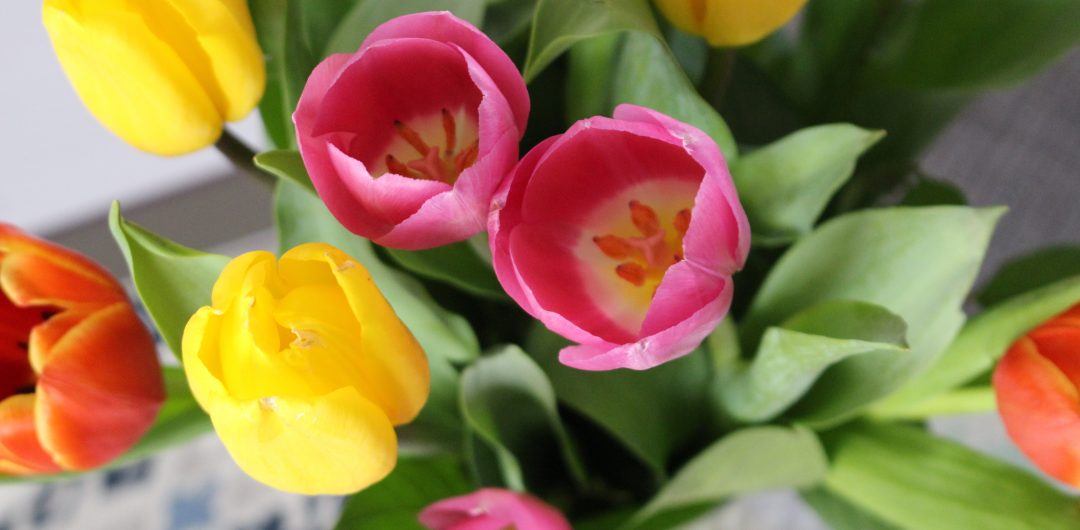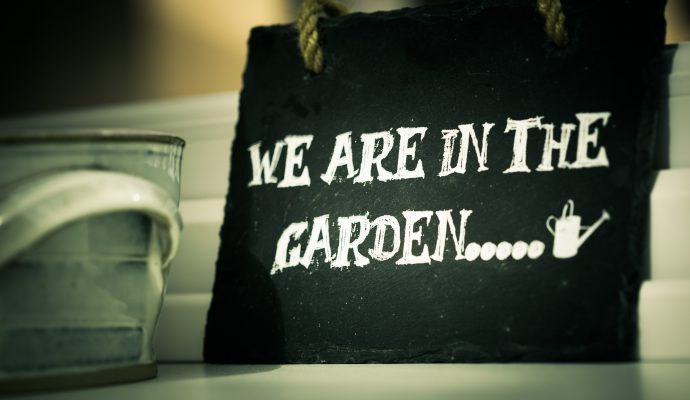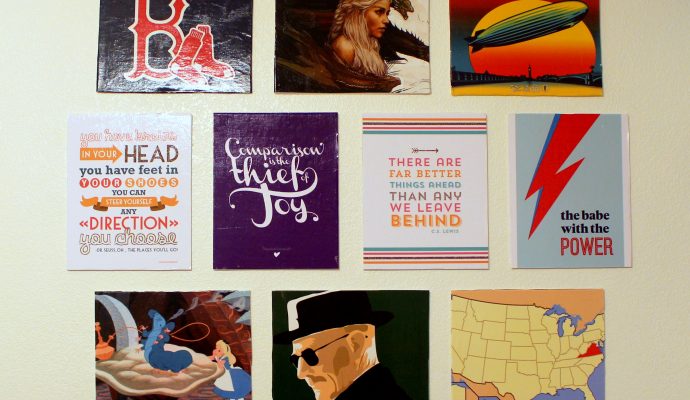I am starting to sense that spring might finally be an imminent reality down here in the Rocky Mountain foothills! The snow is melting just in time for the mountains to get pounded with another round of storms all week… here’s to hoping that snow mass stays west! I love to ski in the stuff, but we are getting just a little tired of constantly drying the dogs off after letting them in the yard, shoveling the driveway, having a cold, numb face… Let’s just say that winter has been epic, but I’m ready for the season change. Just like I say at the end of every season.
Around my neighborhood, there are little green plants poking their shoots out all over the place. Since I’m no expert, I can’t tell if these little signs of life popping up by our fence are tulips, alliums, crocuses, or any other similar-looking plant, but I hope we’ll soon find out! Would any of my readers happen to know? I’m thinking tulips but there are no stalks yet.

Sigh.
Any day now!
I get real obsessive over plant growth! I think it’s just the coolest thing to observe and take part in growing these magnificent things that feed you, look beautiful, can be propagated, trained, or can even be on the verge of death and come back to life with proper pruning, among many other fascinating features. This latter fact I would know full and well because it has happened a few times and usually this has revolved around moving to new locations.
Sammy and I have been interested in small-scale farming for quite some time now. We know that at the very least, we want to grow our own food and try to preserve what is left. Or sell / share it. Since we are new to this, we have no clue what to expect our yield to be and that makes planning a little difficult. We also have other factors affecting our new garden that we will have to plan around and work with:
- Hardiness zone 5 here in Colorado, as opposed to zone 7 in North Carolina
- A shorter growing season with our last frost generally accepted as May 15th and the first fall frost around October 15th
- A lot less rain! But on the other hand, we do have 300 days of sunshine 🙂 I’ve seen the other 65 described as “65 days of WTF”…. this is totally accurate.
- A serious rabbit population that is BOOMIN’ and hungry for greens
- Soil that is more sandy and less fertile than what we are used to
The last people who lived in this house installed a long hose for irrigation, but they removed the piece actually connecting it to the spigot, and they also cut the hose. Thanks guys! Now we start from scratch and have to remove all this useless hosing around the garden beds. We haven’t gotten far enough along to figure this part out yet, so more to come.
Pick A Layout
Sammy used his handy Lufkin Measuring Wheel to walk around and take measurements along our intended bed areas.
Area 1:

Area 2:

Area 3:

Area 4:

We intend to use the square foot gardening concept, so based on our gardening areas and to keep it all manageable, Sammy broke it down into 4×4 raised garden boxes. Area 1 will have eight boxes in two rows of four boxes. Areas 2, 3 and 4 will each have three boxes side-by-side. Depending on how we decide to lay them out, some of these boxes will contain trellises to support either tall plants needing assistance or vines needing something to climb. These boxes with trellises likely will also be in areas 3 and 4. Our grand total comes to 17 boxes, 15 of which will contain vegetables and the other two will be flowerbeds 😀
As you can see in areas 1 and 2, there is a large tree in the middle of the old garden bed, so I know there is a root system in those beds that I don’t want to disturb. I also would expect these roots to be relatively shallow given the low amount of precipitation that is typical here. Building raised beds should help greatly!
Area 4 was a newer addition to the plan. It will require the most work since we have to first get rid of all the decorative gravel and step-stones that are currently in place. The trellises should help build some natural privacy for the lean-to patio which we were not using for anything anyway.
Choose Your Plants
Sammy discovered Botanical Interests, a well-known seed provider that is right here out of Broomfield, CO. We decided to go with them since they had good prices and good quality seeds. Not to mention, we are supporting local!
I might have gone a little crazy, but I have high hopes! Here is what we intend to grow:

I also have a whole variety of different flowers to grow, including this Water Wise Flower Seed Mix made up of known drought-tolerant plants, and this Midwestern Flutter Flower Seed Mix which should help attract butterflies known to inhabit this area.
TWO WHOLE BEDS OF FLOWERS! So. Pumped.
Assuming we get them to grow…
But based on that list, I plan to make a lot of salsa and it’s obviously going to be muy caliente! Just the way I like it. Grow little babies, grow!
Sowing Seeds
This is the part that scares me the most since I am used to just browsing the outdoor shelves at Lowe’s and picking up a few tomatoes, herbs and peppers here and there that are 6-10 inches tall and are already well-established. But since we have a shorter growing season here and many of our chosen vegetables are early season producers, I had to do some research to find my best options.
Using the good old Farmer’s Almanac online, I found this Denver Seed Planting Guide that I used to determine when and how I would start different seeds. I then used the Notes pages in my monthly planner to go through the list and write down which weeks certain plants would need to be either sowed indoors, or put in the ground outside.

Using May 12th as our last frost date, I then backtracked from that day marking off the weeks. As you can see in this picture, we are coming up on 6 weeks prior to the last frost date, I need to get broccoli and Brussels sprouts started indoors this Thursday, and then we will need to get onions and spinach in the ground outdoors around April 1st.
This means we need a couple completed beds by Thursday!
OMGGGGGGG.
We did have some wood laying around from a previous project, so these two beds are physically built, but we still have work to do. The ground should be tilled enough to loosen it up and provide some aeration from being trapped under the snow most of the winter. We need to do this, as well as general bed cleanup to get rid of the remaining skeletons of last year’s garden. We will also need to finalize where we are getting our soil so that we have enough to at least fill up these two beds for now. The recommended ratio according to the Square Foot Gardening Soil Plan is 1/3 vermiculite, 1/3 peat moss, and 1/3 compost. We have been making our own compost and it’s not quite ready yet, so we may have to invest in all the soil components for at least this first go-round.
We also had to calculate the total number of seeds to sow for each vegetable. I am not a math person in the least and the very thought of these types of calculations makes my sphincters clinch, so I threw my hands up in the air saying, “it was my understanding that there would be no math!” It only makes sense to let the guy whose last job was a Financial Analyst do this part, right? Let the Biology major work with the plants. Efficient.
TEAMWORK.
This is the main chart he used to calculate our numbers that I found on Eat Live Grow Paleo:

Once we had our numbers, we went to work with our potting soil and our Seed Starting Greenhouse Trays to get all our vegetable seeds in dirt according to the Almanac. These included the tomatoes, all varieties of peppers, mesclun, and cauliflower so far.
At the beginning of each new week, I turn the page in my planner and take note of what baby seeds need nurturing that week and I will add new notes/lessons/considerations/tasks as we go along.
As of today, this is where we are:

Babies!!!!
Those are some of the mesclun lettuce seeds sprouting already! Apparently, they move really fast.
Commence my super-stalker status as I peep them every 20 minutes, every single day.
Pest Control
Remember all those rabbits I talked about? There are huge sprawling bushes in our neighborhood that we just assume are the 24/7 Bunny Brothels. We walk a little faster. We avert our eyes. We cover our ears from potential love-making sounds (or squeaks). We know more rabbits are in the process of being made each and every time we pass by one of these bushes.
In an effort to keep these naughty boys and girls out of our greens (and the dogs from digging our plants up), we know we must build something to keep them all out. I found this picture from Abundant Mini Gardens to use as an example of what we are going for:

The basic overview is that you use thin PVC pipe to stretch over the bed. This forms the support for you to then hang bird netting or chicken wire (or whatever you prefer!) over the frame. The netting is held to the frame with something like zipties (shown here with clothespins) to keep the critters out. There are many options for which type of netting/fencing to use and we still have our work cut out, but we KNOW for a fact that this is of maximum importance for us to be successful since we live smack dab in the middle of Rabbit Town.
We are planning on doing what we can to keep this all organic, and that definitely goes for pest control. No Seven Dust here if we can help it! I do already have a large bag of Diatomaceous Earth leftover that I purchased a couple years ago in an attempt to switch to natural flea/tick control for the dogs. Diatoms are little unicellular types of algae that have hard cell walls made of silica, making them into these beautiful little life forms that look like a kaleidoscope if you were to view them under a microscope. When they die, their fossilized remains can be used as a sedimentary powder in the form of diatomaceous earth (or DE) as a method for natural pest control. One note here though is that DE only works on critters with exoskeletons (ants, spiders, grasshoppers, roaches, etc.). If you think of each hardened diatom as a tiny shard of glass, it makes sense. It tears up the insides of these pests as it passes through and kills them. BUT, it does not work on soft-bodied critters, such as snails or worms (or humans). So we will need to keep our thinking caps on and get creative in our pest battle!
Special Considerations
As I mentioned before, our rainfall situation could pose a problem, or at least it WILL cause a serious spike in our water consumption! We haven’t truly taken the time to sit down and map this one out yet, but we know it’s on the list. I am going to be investigating some easy ways to save a penny around the house to compensate for this inevitable water bill attack, but for now I just keep thinking about all the money we will be saving by having our own produce in our backyard… that’s good enough for now.
Colorado actually outlaws the use of water barrels due to our desert-like water sitch. For each person using a barrel, the thought process is that they are taking that much more water out of our delicate ground water system that we need region-wide to function, not to mention we cannot guarantee that a person may have properly treated it as it re-enters the water system. It all comes down to a thing called “water rights”, or the rights of a person to take water from a natural source of groundwater (creeks, rivers, streams, and apparently rain). Water rights are controlled usually by the federal government, but here in the United States we allow the states themselves to define and handle it. In Colorado specifically (and much of the arid western U.S.), we have an appropriation system of water law in effect which is 1) first come first serve for those institutions or citizens with a more senior level “water right” in times of water shortages, and 2) only allows people to appropriate a source of water for a separate use that must serve a beneficial purpose. Any excess water must be returned to the source. The appropriation system is in contrast to the riparian system used in the wet Eastern half of the U.S. The riparian system is dependent on land-ownership and creates a bit of an unfair advantage for the ability to use natural water, whereas the Appropriation system seems to serve the greater good by ensuring that all use of water is for a beneficial purpose. It would appear that in our state, water rights have not trickled down to your average individual backyard gardeners, so water barrels are just not something we are allowed to have. I did find this article in the Denver Post about the possibility of local government changing the water barrel law in the near future, but for now, we wait.
A topic of discussion for many gardeners is that of companion planting which takes into consideration plants that thrive off of growing next to each other, and those that do not grow as well in close proximity. Sammy has put together some layouts for different types of 4×4 boxes based on the quantities we plan to grow. I am acting as the “fact-checker” and going behind him to compare to the companion planting charts available and make sure all our plant babies will play nice at daycare. I still need to do this for his current plans, but I will share once we nail them down. Here is an example of a companion planting chart from Paul’s Mowing:

I have found several other charts on Google and Pinterest for anyone looking for more!
Soooo much to keep in mind! I am going to put a chart together of all the things we are growing with pertinent information such as days to germination, sun preference, soil considerations, days to harvest, etc. Then I will know exactly when I should be seriously stalking my seed trays…. or I’ll probably just stalk them anyway.
Part 1 is brought to you by a girl continuing to learn a million new things every day! Stay tuned for Part 2.
And please send my plant babies good vibes!
I have this nagging feeling that they might need it. 🙂




What a lot of work you have put into your research! Trial and error, especially living in a new place, but I have a good feeling! Can’t wait to see what comes up!!! Yummy salads and salsa!
Oh and I think those are tulips:)
I really hope so! Got Brussels babies sprouting up today too. Definitely a lot of research but hopefully we’ll get a nice garden out of it!
I love reading your posts! Feel like I am your rough draft soundboard and I love it!!!
Glad you like them 🙂 And yes, you really are!
Wow! I just stick plants in the ground and hope they don’t die!
Me too!!! This is going to be a whole new animal…
[…] my Backyard Gardening for Beginners – Part 1 post, I introduced the layout we were going for originally. I’m just going to say that after […]